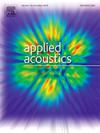Experimental analysis of metamaterial with improved high sound levels absorption using complex frequency plane
IF 3.4
2区 物理与天体物理
Q1 ACOUSTICS
引用次数: 0
Abstract
This study proposes using the complex frequency plane representation as a tool to quantify loss levels of a metamaterial at low sound levels, enabling the prediction of trends in absorption coefficient changes at high sound levels. A multi-resonant metamaterial composed of a series of thin annular cavities connected by a central perforation is considered which has been previously studied in the linear regime. With the analytical model developed for the linear regime, the representation of the complex frequency plane allows understanding whether a low value of absorption peak is due to excessive losses or, instead, to a lack of losses in the material. As sound level increase, material losses rise, leading to decrease in absorption peaks for structures with excessive losses and increase of peak absorption coefficient values for those with insufficient losses. Multi-resonant metamaterials with a constant main pore profile are selected to exhibit resonances with various loss levels, and measurements in a high sound level impedance tube are conducted to validate the expected changes in absorption coefficient. After that, an acoustic black hole is considered and a structure with two low frequency absorption peaks increasing with sound level and presenting a broad absorption band with low sensitivity to high sound levels is identified. The predictions are validated experimentally.
求助全文
约1分钟内获得全文
求助全文
来源期刊

Applied Acoustics
物理-声学
CiteScore
7.40
自引率
11.80%
发文量
618
审稿时长
7.5 months
期刊介绍:
Since its launch in 1968, Applied Acoustics has been publishing high quality research papers providing state-of-the-art coverage of research findings for engineers and scientists involved in applications of acoustics in the widest sense.
Applied Acoustics looks not only at recent developments in the understanding of acoustics but also at ways of exploiting that understanding. The Journal aims to encourage the exchange of practical experience through publication and in so doing creates a fund of technological information that can be used for solving related problems. The presentation of information in graphical or tabular form is especially encouraged. If a report of a mathematical development is a necessary part of a paper it is important to ensure that it is there only as an integral part of a practical solution to a problem and is supported by data. Applied Acoustics encourages the exchange of practical experience in the following ways: • Complete Papers • Short Technical Notes • Review Articles; and thereby provides a wealth of technological information that can be used to solve related problems.
Manuscripts that address all fields of applications of acoustics ranging from medicine and NDT to the environment and buildings are welcome.
 求助内容:
求助内容: 应助结果提醒方式:
应助结果提醒方式:


